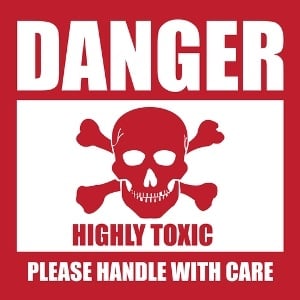
Certain foods have been classed as “poisonous to our health” by the popular press and public opinion (e.g. trans-fats, MSG and, more recently, sugar), but we tend to forget that our food can also be contaminated with actual poisons.
There are the classic poisons like arsenic and cyanide, as well as heavy metals, aflatoxins and mycotoxins such as patulin, which are produced by moulds that grow on food and goitrogens that can affect the function of the thyroid gland – to name just a few categories of poisons that can occur in food.
Arsenic and cyanide
Arsenic and cyanide are two poisons that respectively occur in two of the world’s important staple foods, namely rice and cassava.
a) Arsenic
A recent article by Etan Smallman, highlighted a British TV investigation carried out by Channel 4 in the UK. The survey found that a variety of popular foods which contain rice may also contain arsenic. This revelation may come as a shock to many people who eat breakfast cereals made of rice or rely on rice as a staple food.
The TV programme revealed that in countries like India and Bangladesh, arsenic is leached out of the soil into water, and then absorbed by the rice plants that grow in paddies submerged in the contaminated water.
Read: Arsenic poisoning
Smallman advises that the solution to potential arsenic exposure is to boil rice in large quantities of water, to drain off the cooking water and then rinse the rice again with generous volumes of boiling water. It would be interesting to know what effect the advent of “modern” rice products has had on our exposure to arsenic.
Modern rice products have changed the method of cooking rice drastically so that quick-cooking rice is not rinsed any more. What risk this poses to our health in terms of long-term exposure to arsenic is not clear.
Hopefully this study and its airing on TV will alert authorities and governments to reconsider the safety levels for the maximum arsenic content of plant products for human and animal consumption.
b) Cyanide
Cyanide may be contaminating our foods in a similar fashion if we take into account how the cyanide traditionally used in the mining industry may well be leaching out of abandoned mine dumps and polluting our water supplies. With the threat of acid mine water penetrating our underground water resources, any metals or toxins dissolved by the potent acids in acid mine water have possibly already contaminated our water supply. Plants absorb the water, domestic animals like cattle and sheep eat the plants (and drink the water), and are in turn eaten by humans . . .
Cassava
Cassava is a staple food that sustains more than half a billion people worldwide. It is used as a source of energy and carbohydrates. A number of starchy products, including tapioca, can be made from the tuberous root of the cassava plant. But cassava tubers and particularly the fresh leaves cannot be eaten raw because they contain compounds called “cyanogenic glucosides”, which can decompose to release hydrogen cyanide. There are two varieties of cassava, the bitter variety which can contain up to 1 gram of cyanide per kg and the sweet variety which contains only about 20 mg of cyanide per kg.
Read: Hijacked truck: potassium cyanide dangers
Populations who cultivate cassava know how to reduce the cyanide content of this staple food. These people generally follow a complex process to remove the cyanide and render the cassava leaves and roots safe to eat. The processing may include soaking (for up to 24 hours), fermentation, cooking (this is sufficient to remove the cyanide in the "sweet" cassava variety, but not from the "bitter" variety), drying, and toasting.
Cassava is grown in many countries, including Nigeria and other West African countries. In West Africa the cassava roots are peeled, and allowed to ferment in water for three days. The fermented roots are then dried or cooked. Despite removal of most of the cyanide, the populations that rely heavily on cassava as a staple food may be exposed to long-term low-level cyanide poisoning and develop goitre and a condition known as “tropical ataxic neuropathy” which leads to nerve damage.
Other heavy metals
The name “heavy metals” is used for metals that are potentially toxic no matter if they are “heavy” in terms of density (e.g. lead with a density of 11.34 g/cm3) or light (e.g. arsenic with a density of 5.727 g/cm3).
Heavy metals include arsenic, mercury, cadmium, lead, chromium, cobalt, nickel, copper, zinc, selenium, silver, antimony, and thallium. These are all chemicals that occur naturally in our environment, in the soil, water and the air. While some of these metals are trace elements that play important roles in human metabolism when ingested in minute quantities (e.g. chromium, copper, zinc, selenium), there is always the risk that heavy metals can be deposited in our food and cause health problems if they accumulate over time.
Read: Heavy metals found in SA pineapples
Individuals who overdose on trace elements like chromium, selenium and zinc from supplements in an effort to boost their health, are also at risk of exposing themselves to the risk of heavy metal poisoning.
Water, food and air
Organisations such as the EU, the WHO and governments formulate laws and regulations to determine safe levels for heavy metals in the environment and food. With ever increasing human activity such as mining and manufacturing in every corner of the globe, more and more heavy metals are released into the water we drink, the food we eat and the air we breathe. Examples of this exposure include the mercury contamination of fish, particularly those at the top of the food chain like tuna and marlin, contamination of air in many mega-cities where petrol fumes still contain high levels of lead, and water supplies that have been polluted by cadmium.
According to Smallman, vegetarian are particularly vulnerable to being exposed to the risk of cadmium poisoning because most vegetables and cereal grains naturally contain cadmium derived from the soil. Cadmium which is classified as both a carcinogen and a renal toxin, is not excreted from the body, thus causing build-up in the liver and the kidneys that can lead to kidney disease in the long-term. To reduce the risk of ingesting cadmium you should wash fresh produce thoroughly to remove any cadmium-polluted soil particles that stick to the outside and also peel vegetables if necessary.
Read: Heavy metals found in China tobacco
Aluminium which is used for manufacturing cold drink cans and the shiny lining of long-life cardboard cartons can also be absorbed into food and drinks and find its way into our bodies where it is deposited in the brain and central nervous system. Some researchers have linked aluminium intake with neuro-degenerative conditions such as Alzheimer’s and Parkinson’s disease, although this association has not yet been conclusively proven.
In South Africa many people still use aluminium pots and cooking utensils. When acidic foods are cooked in aluminium pots, some aluminium may dissolve in the acid and be ingested along with the food. Whenever possible, aluminium pots should be anodised. Anodising entails treating aluminium utensils to deposit an oxide layer over the aluminium, making the metal more resistant to corrosion and less likely to be dissolved by acids or strong alkalis during cooking.
Our world contains many potential poisons which may cause acute poisoning (eating raw cassava) or chronic ill health, such as goitrogens which affect the function of the thyroid gland. To remain healthy we should do everything we can to avoid constant exposure to these chemicals.
Read more:
Arsenic poisoning
Prevention of food poisoning
Poisons lurking in the home
References:
- EFSA (2014). Metals as contaminants in food.
- Fletcher D (2010). Cassava. ; Latin Food (2014). Two types of cassava.
- Smallman E (2014). The poisons in your shopping trolley
Image: Highly toxic from Shutterstock




 Publications
Publications
 Partners
Partners














